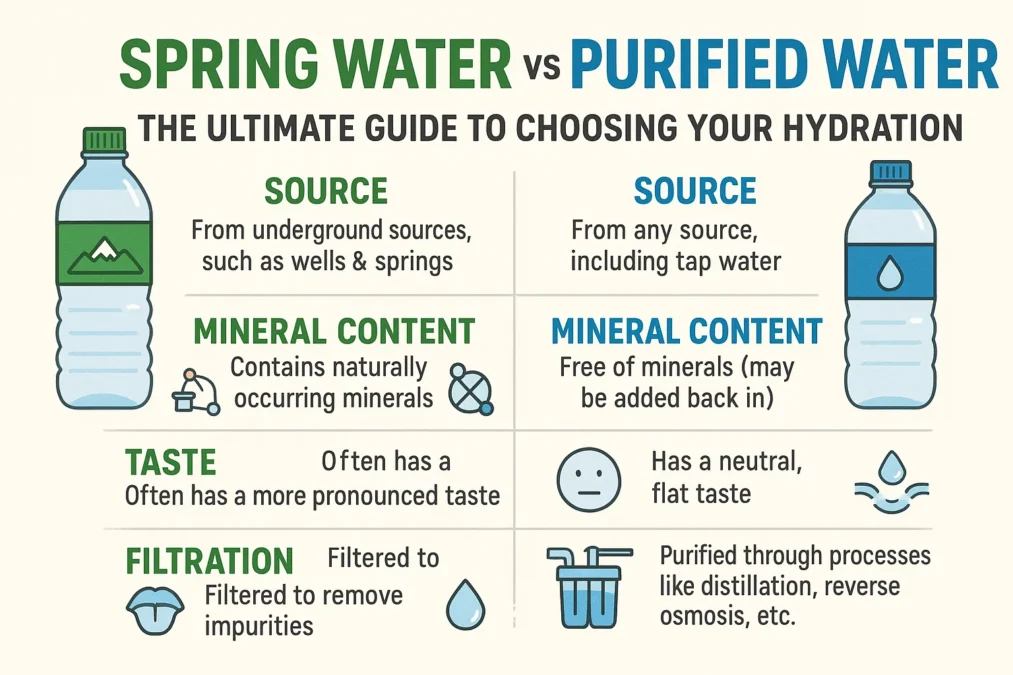Water is the essence of life. It makes up about 60% of our bodies and is crucial for virtually every bodily function, from regulating temperature to flushing out toxins. But when you stand in front of a wall of options at the grocery store, the choice can feel overwhelming. Two of the most common and often confused types are spring water and purified water. While both are perfectly safe to drink, they come from different places, undergo different treatments, and offer different experiences. Understanding the nuances between spring water vs purified water is key to making an informed decision that aligns with your health goals, taste preferences, and values. This comprehensive guide will dive deep into the origins, processing, benefits, and drawbacks of each, transforming you from a confused shopper into a savvy water connoisseur.
What is Spring Water? From the Source to Your Bottle
Spring water is exactly what it sounds like: water that originates from an underground aquifer and flows naturally to the earth’s surface. Imagine a natural spring bubbling up from the ground, often in a pristine, protected environment. This water is collected directly from the spring or through a borehole that taps directly into the underground source. The key defining characteristic of spring water is its origin. For water to be legally labeled as “spring water” in many countries, it must come from a verified underground source and must be collected at the spring or through a borehole that taps the same formation feeding the spring.
The journey of spring water is a natural filtration process. As rainwater and snowmelt percolate down through layers of rock, sand, and soil, they are filtered of many impurities. Along the way, the water can also pick up naturally occurring minerals like calcium, magnesium, potassium, and sodium. These minerals are not just for show; they contribute to what many describe as the fresh, crisp, and unique “taste of place” that spring water is known for. The mineral composition, known as the TDS (Total Dissolved Solids), varies from spring to spring, giving each brand its distinct flavor profile. This is why water from the Alps tastes different from water sourced in the Rockies.
What is Purified Water? The Science of Purity
Purified water represents a category defined not by its source, but by its final state of purity. The term “purified” means that the water has been treated and processed to remove all chemicals and pathogens, reducing the total dissolved solids to a very low level. The source water for purified water can be virtually anything: it might start as municipal tap water, well water, or even spring water. The origin is almost irrelevant because the purification process is so rigorous that it strips the water down to its almost pure H₂O form.
The methods used to achieve this purity are where the science comes in. Common purification techniques include reverse osmosis, distillation, deionization, and absolute 1-micron filtration. Reverse osmosis forces water through a semi-permeable membrane that filters out a vast majority of contaminants, including bacteria, viruses, and dissolved salts. Distillation involves boiling the water into vapor and then condensing it back into liquid, leaving most impurities behind. The U.S. Pharmacopeia (USP) sets strict standards for purified water, requiring it to have no more than 10 parts per million (ppm) of total dissolved solids. This intense processing is what fundamentally separates spring water vs purified water in terms of composition.
Key Differences: A Head-to-Head Comparison
The debate between spring water vs purified water hinges on several core differences: their source, mineral content, taste, and the processing they undergo. Spring water is prized for its natural origin and mineral profile, while purified water is defined by its engineered purity and consistent, blank-slate taste. It’s a classic case of nature versus science. One isn’t inherently better than the other; rather, they cater to different priorities. Someone seeking natural minerals and terroir might gravitate toward spring water, while another person concerned about specific contaminants or wanting a neutral taste for cooking might choose purified water.
To make the choice clearer, it helps to visualize these differences side-by-side. The following comparison table breaks down the essential characteristics of each type of water, providing a quick and easy reference to understand what sets them apart. This comparison highlights why the choice between spring water vs purified water is so personal and dependent on individual needs.
Comparison Table: Spring Water vs Purified Water
| Feature | Spring Water | Purified Water |
|---|---|---|
| Source | Natural underground aquifer that flows to the surface. | Can be any source (municipal, well, etc.); source is irrelevant due to processing. |
| Processing | Minimal; typically filtered for sediment and disinfected (often with ozone or UV). | Extensive; uses reverse osmosis, distillation, or deionization to remove impurities. |
| Mineral Content | Contains naturally occurring minerals (e.g., calcium, magnesium). | Minerals are removed during the purification process. Some brands add minerals back for taste. |
| Taste | Often described as crisp, fresh, or having a distinct flavor due to its mineral profile. | Neutral, flat, or “clean” due to the lack of minerals. Can taste bland to some. |
| Regulatory Standards | Must be from a protected underground source and meet FDA standards for spring water. | Must meet USP standards for purified water, meaning TDS of 10 ppm or less. |
| Environmental Impact | High due to plastic bottle production and transportation from often-remote sources. | Varies; can be high for bottled, but home filtration systems drastically reduce plastic waste. |
| Primary Use | Drinking and hydration for those seeking natural minerals and taste. | Drinking, cooking, medical equipment, laboratories, baby formula (where purity is critical). |
The Taste Test: Nature’s Flavor vs. A Clean Slate
One of the most immediate and noticeable differences in the spring water vs purified water debate is the taste. Your palate is likely already familiar with the distinction, even if you haven’t consciously identified it. Spring water, with its unique blend of minerals, offers a taste experience. The dissolved solids, specifically calcium, magnesium, and bicarbonate, give the water a distinct mouthfeel and flavor that many describe as “refreshing” or “crisp.” Water sommeliers, much like wine experts, can often identify the source of a spring water based on its mineral composition and taste profile.
Purified water, on the other hand, is the definition of neutral. The purification process removes not only potentially harmful contaminants but also the minerals that give water its character. The result is water that tastes very flat, clean, and empty. For some, this is the ideal taste—or lack thereof. It doesn’t interfere with the flavor of coffee, tea, or food when used in cooking. However, others find this blandness to be unappealing for casual drinking. It’s worth noting that many bottled purified water brands will add a minimal amount of minerals back into the water after purification. This isn’t for health benefits but solely to improve the taste and make it more palatable to a wider audience.
Health and Hydration: Minerals vs. Pure H₂O
When it comes to the core function of hydration, both spring water and purified water are excellent choices. Your body will be equally hydrated whether you drink water from a natural spring or water that has been through a reverse osmosis filter. The primary health consideration in the spring water vs purified water discussion revolves around minerals. Spring water can be a modest source of essential minerals like calcium and magnesium. While you shouldn’t rely on water as your sole source of these nutrients, every little bit helps contribute to your daily recommended intake, especially for individuals with diets that may be lacking.
Purified water offers a different kind of health benefit: certainty. For individuals with compromised immune systems, those living in areas with known water contamination issues, or parents preparing baby formula, the guaranteed removal of pathogens, chemicals, and heavy metals is a significant advantage. The lack of minerals is not typically a health concern in a balanced diet, as the vast majority of your minerals will come from food. The choice, therefore, is less about which is “healthier” and more about your personal needs. Do you value a natural, minimal supplemental source of minerals, or is the assurance of maximum purity more important for your situation?
Environmental and Economic Considerations
The environmental impact of bottled water is a critical factor that extends beyond the spring water vs purified water discussion. Both types, when sold in single-use plastic bottles, contribute significantly to plastic pollution, carbon emissions from transportation, and resource depletion. Spring water companies are often criticized for commercializing a public resource, sometimes impacting local ecosystems and water tables around their extraction sites. The environmental cost of trucking heavy bottles of water across the country is substantial.
From an economic perspective, purchasing bottled water of any kind is vastly more expensive than drinking tap water. However, the purified water category has a strong advantage here: home filtration systems. Investing in a under-sink reverse osmosis system or a high-quality countertop filter allows you to create your own purified water at home for a fraction of the per-gallon cost of bottled water. This approach dramatically reduces plastic waste and gives you control over your water’s purity. While you can also find spring water delivery services in large reusable jugs, the home purification route is generally more efficient, customizable, and environmentally friendly for those seeking pure water.
Seltzer vs Sparkling Water: The Ultimate Guide to Bubbly Waters
How to Make the Right Choice for You
So, after all this, how do you decide between spring water vs purified water? The answer is deeply personal and should be based on your individual priorities. Ask yourself a few key questions. Is taste your primary driver? If you enjoy the distinct flavor of water, explore different brands of spring water to find one whose mineral profile you prefer. Is absolute purity your main concern, perhaps for health reasons or for use in appliances? Then a purified water option, especially from a home filtration system, is likely your best bet.
Consider your lifestyle and values. If you are deeply concerned about plastic waste, a home water filter is the most sustainable choice for either type. If you want the convenience of bottled water but prefer spring water, look for brands that use recycled plastic and have strong environmental commitments. Remember, the best water for you is the water you will actually drink consistently. Staying hydrated is the ultimate goal, and both spring water and purified water will meet that fundamental need effectively.
Conclusion
The journey through the world of spring water vs purified water reveals that there is no single winner. Each type holds its own unique value. Spring water connects us to nature, offering a taste of the earth’s mineral richness and a refreshing drinking experience straight from a protected source. Purified water represents the pinnacle of human ingenuity in water treatment, providing a guaranteed safe and neutral-tasting option for drinking, cooking, and specialized uses. Your ideal choice depends on whether you prioritize natural mineral content and terroir or assured purity and consistency. By understanding the key differences in source, processing, taste, and impact, you can move beyond the marketing hype and make an empowered decision that ensures you stay healthily hydrated in a way that works best for you and your family.
Frequently Asked Questions (FAQs)
What is the main difference between spring water and purified water?
The main difference in the spring water vs purified water debate lies in their source and processing. Spring water comes from a specific, natural underground source and is treated minimally to preserve its natural mineral composition. Purified water can come from any source and undergoes rigorous processing like reverse osmosis or distillation to remove all impurities and minerals, resulting in water that is nearly pure H₂O.
Is spring water healthier than purified water?
Both are effective for hydration. Spring water contains natural minerals like calcium and magnesium, which can offer a minor nutritional benefit. Purified water is free from contaminants, which is crucial for those with weakened immune systems. Neither is definitively “healthier”; the better choice depends on whether you value natural minerals or guaranteed purity in your water.
Why does purified water taste different?
Purified water often tastes flat or neutral because the purification process removes the minerals and dissolved solids that give spring water its distinct, crisp flavor. The absence of these minerals results in a very clean but bland taste profile that some people prefer, especially for mixing with drinks like coffee or protein shakes.
Can I use purified water in my appliances like humidifiers and CPAP machines?
Yes, absolutely. Using purified water, particularly distilled water (a type of purified water), is highly recommended for appliances. This is because the mineral-free nature of purified water prevents scale buildup and mineral deposits that can clog and damage the mechanisms of humidifiers, steam irons, CPAP machines, and other devices over time.
Is bottled spring water better than filtered tap water?
This depends on your local tap water quality and your goals. High-quality home water filters can produce water that is just as safe, or safer, than many bottled spring waters, and at a far lower cost and environmental impact. However, if your tap water is of poor quality or you simply prefer the taste of a specific natural spring water, then bottled can be a good option. The “better” choice is a balance of taste, cost, convenience, and environmental consciousness.



